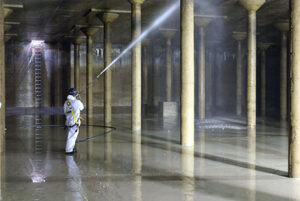
Creating clean water is a science. Jet Blast Inc. offers disinfection and chlorination treatment!
Clean water for drinking and agriculture is something that many rarely think about, but creating this water is a scientific and engineering feat. Today, the United States and other countries have more or less perfected the disinfection of water systems, but there is always more to explore in this matter. What is the disinfection of water systems, and what more is there to learn about it?
What’s the Goal?
According to the National Institute of Health, the goal of the disinfection of water systems is to eliminate pathogens that produce waterborne illnesses. Bacteria that dwell in H2O thrives, multiplies, and can cause great fatalities. Therefore, finding an effective way to stop these bacteria from multiplying and kill them off is necessary for creating clean water. However, this does not mean that all living organisms are exterminated from the water. That would be called sterilization, which is nearly impossible to deliver to the public user. Even so, the amount of microbes that still exist after disinfection is very small and ineffective at producing harmful pathogens.
Determining the Best Disinfection Method
What qualifies as an excellent disinfection method? There are at least five qualifying factors:
- How well can it kill off bacteria, protozoa, pathogens, helminths, and other pathogens
- How well the disinfectant can be monitored and controlled
- Can it produce a residual that safeguards against contamination after treatment
- Does the drinking water look and taste good
- Are the technology and tools available for the given population
Chlorination as Disinfection
The disinfection of water systems can involve different chemicals, but chlorine is still the most popular. Different countries have used chlorine as a disinfectant for different purposes for hundreds of years. The United States has used chlorine to disinfect water systems for over 60 years. It is tried and true, so much so that waterborne illnesses are virtually a thing of the past in the United States. While chlorinated water does not seem to have any harmful effects on people, it could produce halogenated hydrocarbons, which are toxic. Therefore, alternative disinfectants are under study, without denying that chlorinated water is still safe.
Other Disinfection Options
Other options used in the disinfection of water systems include ozone, chloramine, ultraviolet light, and chlorine dioxide. For more information on the disinfection and chlorination of water systems, contact Jet Blast Inc.!
Contact Jet Blast Inc. Today!
Jet Blast® Industrial Services strives every day in an effort to provide our customers with the best service and equipment possible. Providing a safe and stable workplace has allowed us to keep a team of quality people with most having a tenure of 15 – 25 years with Jet Blast®. With all that experience under one roof, we have been able to provide reliable 24-hour service for over 42 years. I believe this helps to set us apart from the competition.
Compare us! Let us make your job easier. If you’re located in Maryland, Pennsylvania, Delaware, Northern Virginia, or Washington, D.C., contact us by email at [email protected], call us at 410-636-0730, or fax us at 410-789-3907, and don’t forget to keep in touch with us on Facebook!
